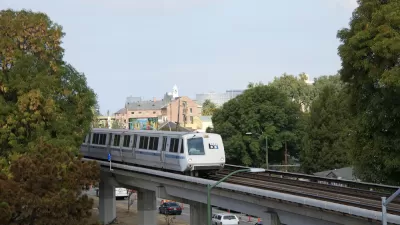The oldest commuter rail line west of the Mississippi is also unique in another way—it lacks a dedicated source of operating revenue. Legislation has been introduced to allow Peninsula counties to vote to increase sales taxes by 0.125 percent.

While Caltrain has one of the highest farebox recovery ratios in North America at 63 percent, that still leaves about 37 percent that is filled by "voluntary contributions from the three counties participating in the joint powers authority, and is the only passenger rail service in the U.S. to be financed in that manner," reports Sara Gaiser of Bay City News.
Senate Bill 797, introduced by state Sen. Jerry Hill, D-San Mateo, along with several other Bay Area senators and Assembly members, would authorize the Peninsula Corridor Joint Powers Board, which runs Caltrain, to place a one-eighth-cent sales tax on the ballot in San Francisco, San Mateo and Santa Clara counties.
SB 797 is intended to end fluctuations in those contributions and establish a reliable funding source, according to Hill.
The bill, introduced late in the legislative season on June 21 through the gut-and-amend process, i.e., stripping an unrelated bill that had cleared the Senate on May 31 and inserting the new text, so the bill went directly to the Assembly Rules Committee. While the bill need only pass with a majority vote and be signed by Gov. Jerry Brown, there are additional challenges.
The measure could only be placed on the ballot once the joint powers board gives it two-thirds approval. The boards of supervisors for San Francisco, San Mateo and Santa Clara counties and transportation authorities in the three counties would also have to approve it [by majority vote].
The final step is approval by the voters, also by a two-thirds supermajority. The legislation does not set a date for the election.
"The bill is backed by business groups including the Silicon Valley Leadership Group (SVLG) and SAMCEDA, the San Mateo County Economic Development Association," reports Adina Levin for Friends of Caltrain. According to Katy Murphy of The Mercury News, SVLG is sponsoring the bill.
“We all pay a little bit and we all prosper a lot,” said Carl Guardino, CEO of the business group.
"The revenue would generate roughly $100 million annually for Caltrain," adds Murphy. Caltrain's fiscal year 2017 budget [pdf] is $146,392,029.
Caltrain will begin a $2 billion modernization project this summer, including electrification of the diesel-powered line that runs 92 trains daily. While electrification should decrease operating costs, the number of trains should increase greatly.
Too many sales taxes?
"The statewide sales tax is 7.25 percent, but many cities and counties have their only sales taxes," notes Murphy. "If voters in three Bay Area counties agree to increase the sales tax by an eighth of a cent to help fund Caltrain, this is what the new rates would be:"
Santa Clara County: 9.125 percentSan Mateo County: 8.875 percent.San Francisco: 8.625 percent
Source: Board of Equalization
Competing transportation tax measure
Legislation authorizing another Bay Area transportation ballot measure, SB 595, also known as Regional Measure 3, would permit voters in all nine Bay Area counties to increase tolls on the seven state-owned Bay Area toll bridges (the Golden Gate Bridge not being one of them) by as much as 60 percent.
Presumably, but not necessarily, the Metropolitan Transportation Commission, the administrative body behind RM 3, would work with the Caltrain board to ensure both measures do not appear on the same ballot should both bills become law and be approved by their governing bodies.

Alabama: Trump Terminates Settlements for Black Communities Harmed By Raw Sewage
Trump deemed the landmark civil rights agreement “illegal DEI and environmental justice policy.”

Planetizen Federal Action Tracker
A weekly monitor of how Trump’s orders and actions are impacting planners and planning in America.

How Atlanta Built 7,000 Housing Units in 3 Years
The city’s comprehensive, neighborhood-focused housing strategy focuses on identifying properties and land that can be repurposed for housing and encouraging development in underserved neighborhoods.

In Both Crashes and Crime, Public Transportation is Far Safer than Driving
Contrary to popular assumptions, public transportation has far lower crash and crime rates than automobile travel. For safer communities, improve and encourage transit travel.

Report: Zoning Reforms Should Complement Nashville’s Ambitious Transit Plan
Without reform, restrictive zoning codes will limit the impact of the city’s planned transit expansion and could exclude some of the residents who depend on transit the most.

Judge Orders Release of Frozen IRA, IIJA Funding
The decision is a victory for environmental groups who charged that freezing funds for critical infrastructure and disaster response programs caused “real and irreparable harm” to communities.
Urban Design for Planners 1: Software Tools
This six-course series explores essential urban design concepts using open source software and equips planners with the tools they need to participate fully in the urban design process.
Planning for Universal Design
Learn the tools for implementing Universal Design in planning regulations.
Jessamine County Fiscal Court
Caltrans
Institute for Housing and Urban Development Studies (IHS)
City of Grandview
Harvard GSD Executive Education
Toledo-Lucas County Plan Commissions
Salt Lake City
NYU Wagner Graduate School of Public Service




























